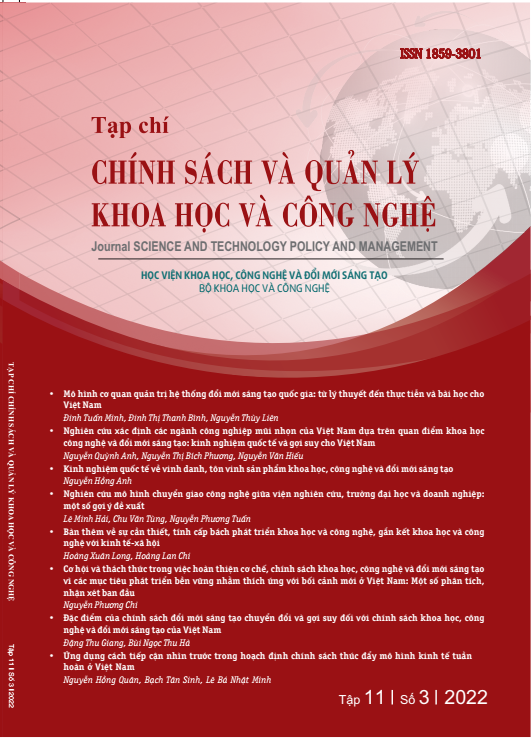Identifying key industries of Vietnam based on science, technology and innovation: international experiences and implications for Vietnam
Keywords:
Innovation, Science and Technology, Key industriesAbstract
The identification of key industries plays an important role in countries to properly support them for economic development, and serving as a driving force to lead other industries. This paper explores science, technology and innovation criteria and how to use these criteria to identify key industries in line with the knowledge-based economic development approach in 21st century from international experience. The implication for science, technology and innovation criteria and corresponding methodology for identifying of key industries in Vietnam are recommended
Downloads
References
Đảng Cộng sản Việt Nam (2021). Văn kiện Đại hội đại biểu toàn quốc lần thứ XIII (Tập II). NXB. Chính trị quốc gia Sự thật.
Huy Hoàn, Lan Anh (2020). Phát triển ngành công nghiệp ưu tiên: Xác định rõ trọng tâm, trọng điểm. <https://congthuong.vn/phat-trien-nganh-cong-nghiep-uu-tien-xacdinh-ro-trong-tam-trong-diem-142336-142336.html> (truy cập: 02/2/2022)
Vũ Thành Tự Anh (2017). Xác định các ngành công nghiệp ưu tiên trong chính sách công nghiệp quốc gia. Báo cáo tóm tắt gửi đến Ban Kinh tế Trung ương. <https://thitruongtudo.vn/chi-tiet/xac-dinh-cac-nganh-cong-nghiep-uu-tien-trongchinh-sach-cong-nghiep-quoc-gia.html
Hoàng Văn Hoan (2011). "Ngành kinh tế mũi nhọn ở Việt Nam: Một số vấn đề lý luận và thực tiễn". Tạp chí Nghiên cứu kinh tế, Số 395-Tháng 4/2011, 24-30.
Vũ Khuê (2022). Công nghiệp Việt Nam đang phát triển mất cân đối. <https://vneconomy.vn/cong-nghiep-viet-nam-dang-phat-trien-mat-can-doi.htm> (truy cập: 2/10/2022)
Trần Thị Mây, Nguyễn Thị Thơm, & Vũ Thị Phượng (2022). "Thực trạng và giải pháp tái cơ cấu ngành Công nghiệp đến năm 2030". Tạp chí Tài chính, Kỳ 1-Tháng 5/2022, 92-94.
Nguyễn Văn Thạo (2022). Phát triển, nâng cao tiềm lực khoa học-công nghệ: Yếu tố hàng đầu để đẩy mạnh và nâng cao hiệu quả cơ cấu lại nền công nghiệp đất nước. https://mof.gov.vn/webcenter/portal/vclvcstc/pages_r/l/chi-tiettin?dDocName=MOFUCM243987 (truy cập: 02/10/2022)
Bùi Trịnh (2018). Thực trạng công nghiệp Việt Nam trong thời gian qua. Thông tin Khoa học Thống kê, 3, 1-6.
ADB (2007). Moving Toward Knowledge-Based Economies: Asian Experiences, Regional and Sustainable Development Department. Manila. <https://www.adb.org/sites/default/files/publication/29699/knowledge-basedeconomies.pdf>
OECD (1996). The knowledge-based economy. General distribution OECD/GD(96)102. <https://www.oecd.org/officialdocuments/publicdisplaydocument pdf/?cote=OCDE/GD%2896%29102&docLanguage=En>
UNCTAD (2010). Science, technology and innovation indicators for policymaking in developing countries: an overview of experiences and lessons learned. Investment, Enterprise and Development Commission, Geneva. <https://unctad.org/system/files/official-document/ciimem1crp1_en.pdf>
Ginevičius, R. (2011). A new determining method for the criteria weights in multicriteria evaluation. International Journal of Information Technology and Decision Making, 10(06), 1067-1095. <https://doi.org/10.1142/S0219622011004713>
Keršuliene, V., Zavadskas, E. K., & Turskis, Z. (2010). Selection of rational dispute resolution method by applying new step‐wise weight assessment ratio analysis (SWARA). Journal of Business Economics and Management, 11(2), 243-258. <https://doi.org/10.3846/jbem.2010.12>
Nezhad, M. R. G., Zolfani, S. H., Moztarzadeh, F., Zavadskas, E. K., & Bahrami, M. (2015). Planning the priority of high tech industries based on SWARA-WASPAS methodology: The case of the nanotechnology industry in Iran. Economic researchEkonomska istraživanja, 28(1), 1111-1137.
<https://doi.org/10.1080/1331677X.2015.1102404>
Powell, W. W., & Snellman, K. (2004). The knowledge economy. Annual review of sociology, 30, 199-220. <https://www.jstor.org/stable/29737691>
Saaty, T. L. (1980). The analytic hierarchy process. McGraw-Hill.
Saaty, T. L., & Vargas, L. G. (2001). How to make a decision. In Models, methods, concepts & applications of the analytic hierarchy process (pp. 1-25). Springer.
Zavadskas, E. K., & Kaklauskas, A. (1996). Multiple criteria evaluation of buildings.
Technika.
Zolfani, S. H., & Bahrami, M. (2014). "Investment prioritizing in high tech industries based on SWARA-COPRAS approach". Technological and Economic Development of Economy, 20(3), 534-553. <https://doi.org/10.3846/20294913.2014.881435>.
Downloads
Published
How to Cite
Issue
Section
License
Authors who publish with this journal agree to the following terms:
- Authors retain copyright and grant the journal right of first publication with the work simultaneously licensed under a Creative Commons Attribution License that allows others to share the work with an acknowledgement of the work's authorship and initial publication in this journal.
- Authors are able to enter into separate, additional contractual arrangements for the non-exclusive distribution of the journal's published version of the work (e.g., post it to an institutional repository or publish it in a book), with an acknowledgement of its initial publication in this journal.
- Authors are permitted and encouraged to post their work online (e.g., in institutional repositories or on their website) prior to and during the submission process, as it can lead to productive exchanges, as well as earlier and greater citation of published work (See The Effect of Open Access).

